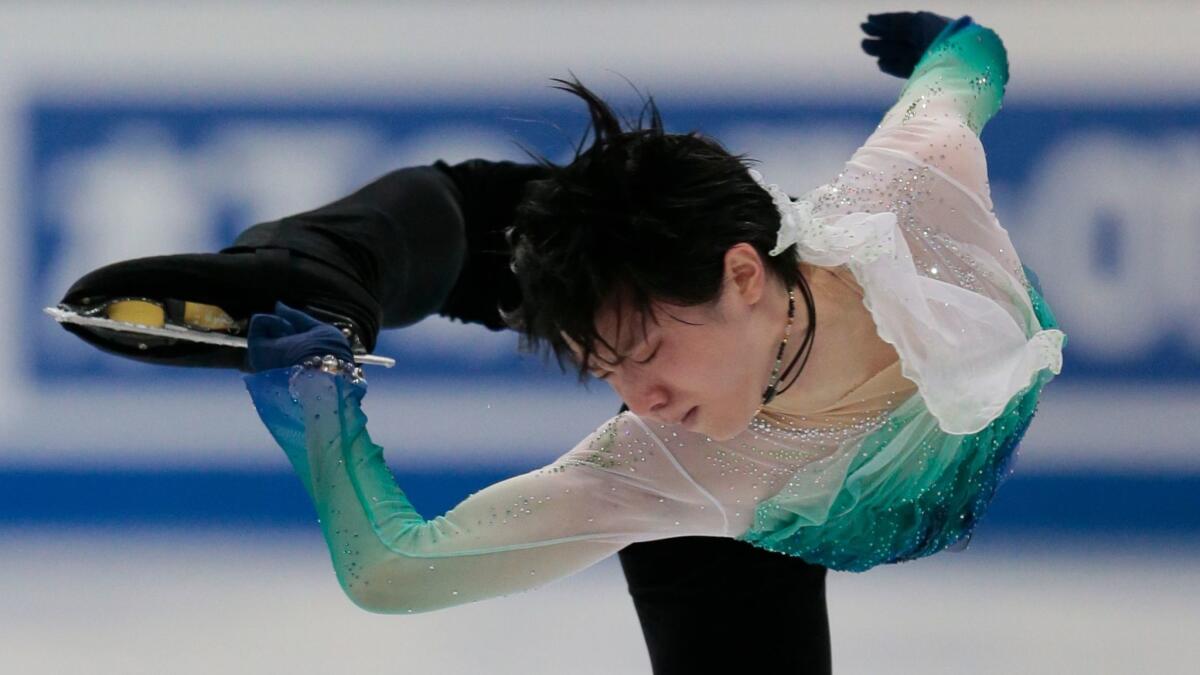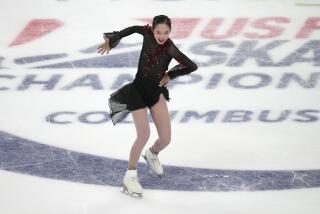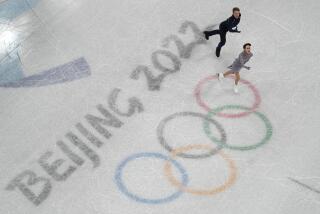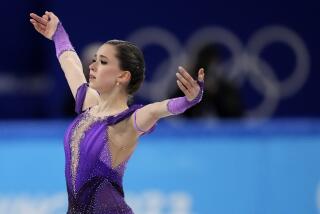Column:: No clear favorites heading into men’s and women’s Olympic figure skating

The next chapter of Olympic figure skating history hinges on the state of Yuzuru Hanyu’s injured right ankle.
Hanyu became the first Japanese man to win an Olympic figure skating gold medal when he prevailed at Sochi in 2014, and at 19 the youngest male singles skater to become Olympic champion since 18-year-old Dick Button triumphed at St. Moritz, Switzerland, in 1948.
No male singles skater has won the gold medal in two consecutive Winter Games since Button did so in 1948 and 1952, but Hanyu appeared to have an excellent chance at duplicating that after he won the world championship last year with a record 223.20 points in the free skate segment.
Nicknamed “Ice Prince,” and gifted with both artistry and athleticism, he was poised to reign again as the Olympic king.
An unfortunate landing on a quadruple lutz jump on Nov. 9 derailed that narrative and brought the gold medal back within reach of a handful of contenders.
Hanyu damaged ligaments in his ankle in the mishap and was forced to withdraw from all of his subsequent competitions.
He didn’t resume his training regimen in Toronto until early January, and his coach, Brian Orser, said this week Hanyu will skip the Olympic team event to focus on the singles competition.
The team event started on Friday and ends on Monday, followed by the pairs on Feb. 14-15, the men on Feb. 16-17, and the women on Feb. 21 and 23.
The women’s field also became difficult to predict when Evgenia Medvedeva, the first woman to win back-to-back world titles since Michelle Kwan in 2000-01, developed a stress fracture in her right foot in November. That kept her out of the Grand Prix Final and the Russian national competition.
Medvedeva, who holds the International Skating Union scoring records for points in the short program (80.85), the long program (160.46), and total (241.31), returned at the European championships and finished second to her 15-year-old training partner Alina Zagitova, Medvedeva’s first loss in two years. Medvedeva, Zagitova and Maria Sotskova will compete here as Olympic Athletes from Russia.
American women have not won a singles medal in the last two Olympics, a streak that could continue unless Mirai Nagasu of Arcadia — who finished fourth in her Olympic debut in 2010 but didn’t make the team in 2014 — can land her high-scoring triple axel jump.
Midori Ito and Mao Asada of Japan are the only women who have landed the 3 ½-revolution jump in the Olympics; Asada landed three at the 2010 Vancouver Games, the most triple axels performed by a woman in one competition.
The base value of the jump is 8.5 points, plus a possible bonus for grade of execution. Nagasu performed a triple axel in each of her programs at the U.S. championships in January but stepped out on the landings and got 6.07 points for it in the short program and 6.36 points for it in the free skate. The base value of a double axel is 3.3 points.
“For me, it’s worth the risk because I can hit it and it’s pretty consistent in practice,” Nagasu said after her second-place finish at the U.S. competition. “With the minuses I still got six [points], which is worth more than the double axel. So for me it is worth the risk and worth going down in history for.”

With Hanyu’s status unclear, the top men’s contenders are likely to be two-time world champion Javier Fernandez of Spain, Grand Prix Final runner up Shoma Uno of Japan, Jin Boyang of China, and two-time U.S. champion Nathan Chen, who has had his own issues with the quadruple lutz.
Chen didn’t attempt a quad lutz at the U.S. competition, saying he had experienced less success with it than his other quad jumps. He said last week he hadn’t decided if he will try it in Pyeongchang.
“As of now everything is sort of going to plan in terms of training, but that’s still up in the air,” Chen said of the quad lutz, which is worth a hefty 13.6 points and could score even higher if he does it well and gets a positive grade of execution.
His coach, Rafael Arutunian, indicated it could be a strategic decision based on Chen’s comfort level and where he stands in each segment of the event.
“It’s always a type of game, what you want to put in, especially with Nathan when he has so many quads,” Arutunian said. “And these days, not too many people got that. He’s one of the few people who has that.”
The pairs event isn’t easy to predict. World champions Sui Wenjing and Han Cong of China, known for their strengths as individual skaters and their harmony together, can be considered the favorites.
Ukraine-born Aliona Savchenko, a bronze medalist for Germany at the last two Games with Robin Szolkowy, will appear in her fifth Olympics, this time partnered with Bruno Massot.
They finished second at last year’s world championships and beat the Chinese duo at the Grand Prix Final in December.
Evgenia Tarasova and Vladimir Morozov of the Olympic Athletes from Russia, third at last year’s world championships, and Canada’s Meagan Duhamel and Eric Ranford also might crack the top three.
The lone U.S. pair, Alexa Scimeca-Knierim and Chris Knierim, would do well to finish in the top eight.
In ice dancing, the French duo of Gabriella Papadakis and Guillaume Cizeron, last year’s world champions, likely will have to fend off Canadians Tessa Virtue and Scott Moir for gold.
Virtue and Moir prevailed at Vancouver in 2010 but finished second to Americans Meryl Davis and Charlie White at Sochi; Virtue and Moir took two seasons off but returned to pursue gold.
Madison Hubbell and Zachary Donohue skated with enough verve and skill to unseat Maia and Alex Shibutani at the U.S. championships in January and could win a medal, which would extend a three-Games medal streak for U.S. ice dancers after years of drought.
Follow Helene Elliott on Twitter @helenenothelen
More to Read
Go beyond the scoreboard
Get the latest on L.A.'s teams in the daily Sports Report newsletter.
You may occasionally receive promotional content from the Los Angeles Times.






